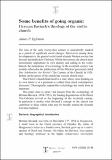Files in this item
Some benefits of going organic: Herman Bavinck’s theology of the visible church
Item metadata
| dc.contributor.author | Eglinton, James | |
| dc.date.accessioned | 2014-11-11T09:26:25Z | |
| dc.date.available | 2014-11-11T09:26:25Z | |
| dc.date.issued | 2010-06-01 | |
| dc.identifier.citation | Eglinton, J. (2010). Some benefits of going organic: Herman Bavinck’s theology of the visible church. Theology in Scotland, 17(1), pp. 23-36. | en_US |
| dc.identifier.issn | 1465-2862 | en_US |
| dc.identifier.uri | http://ojs.st-andrews.ac.uk/index.php/TIS/article/view/5 | en_US |
| dc.identifier.uri | https://hdl.handle.net/10023/5705 | |
| dc.description.abstract | The thought of the Dutch theologian Herman Bavinck (1854–1921) has aroused a great deal of interest of late as a result of the publication of a newly-translated English edition of his magisterial Reformed Dogmatics. James Eglinton’s study of his doctrine of the Church comes as a timely reminder that it is possible to maintain the essential balance in ecclesiological thinking between the visible and invisible Church in a creative way. | en_US |
| dc.language.iso | en | en_US |
| dc.publisher | St Mary's College, University of St Andrews | en_US |
| dc.relation.ispartof | Theology in Scotland | en_US |
| dc.rights | This is an open access article published in Theology in Scotland. This work is licensed under a Creative Commons Attribution-NonCommercial 4.0 License (http://creativecommons.org/licenses/by-nc/4.0/) | en_US |
| dc.rights.uri | http://creativecommons.org/licenses/by-nc/4.0/ | |
| dc.subject.lcc | BR1.S3T5 | en_US |
| dc.subject.lcsh | Theology--Study and teaching--Scotland | en_US |
| dc.subject.lcsh | Theology, Doctrinal--Scotland | en_US |
| dc.title | Some benefits of going organic: Herman Bavinck’s theology of the visible church | en_US |
| dc.type | Journal article | en_US |
| dc.description.version | Publisher PDF | en_US |
| dc.publicationstatus | Published | en_US |
| dc.status | Peer reviewed | en_US |
This item appears in the following Collection(s)
Except where otherwise noted within the work, this item's licence for re-use is described as This is an open access article published in Theology in Scotland. This work is licensed under a Creative Commons Attribution-NonCommercial 4.0 License (http://creativecommons.org/licenses/by-nc/4.0/)
Items in the St Andrews Research Repository are protected by copyright, with all rights reserved, unless otherwise indicated.


